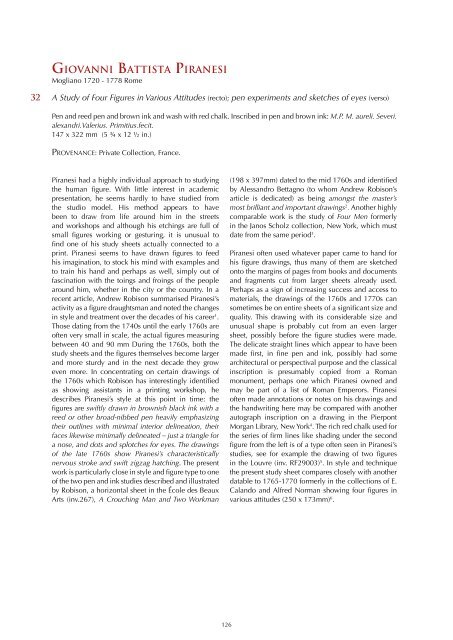Create successful ePaper yourself
Turn your PDF publications into a flip-book with our unique Google optimized e-Paper software.
Giovanni Battista Piranesi<br />
Mogliano 1720 - 1778 Rome<br />
32<br />
A Study of Four Figures in Various Attitudes (recto); pen experiments and sketches of eyes (verso)<br />
Pen and reed pen and brown ink and wash with red chalk. Inscribed in pen and brown ink: M.P. M. aureli. Severi.<br />
alexandri.Valerius. Primitius.fecit.<br />
147 x 322 mm (5 ¾ x 12 ½ in.)<br />
Provenance: Private Collection, France.<br />
Piranesi had a highly individual approach to studying<br />
the human figure. With little interest in academic<br />
presentation, he seems hardly to have studied from<br />
the studio model. His method appears to have<br />
been to draw from life around him in the streets<br />
and workshops and although his etchings are full of<br />
small figures working or gesturing, it is unusual to<br />
find one of his study sheets actually connected to a<br />
print. Piranesi seems to have drawn figures to feed<br />
his imagination, to stock his mind with examples and<br />
to train his hand and perhaps as well, simply out of<br />
fascination with the toings and froings of the people<br />
around him, whether in the city or the country. In a<br />
recent article, Andrew Robison summarised Piranesi’s<br />
activity as a figure draughtsman and noted the changes<br />
in style and treatment over the decades of his career 1 .<br />
Those dating from the 1740s until the early 1760s are<br />
often very small in scale, the actual figures measuring<br />
between 40 and 90 mm During the 1760s, both the<br />
study sheets and the figures themselves become larger<br />
and more sturdy and in the next decade they grow<br />
even more. In concentrating on certain drawings of<br />
the 1760s which Robison has interestingly identified<br />
as showing assistants in a printing workshop, he<br />
describes Piranesi’s style at this point in time: the<br />
figures are swiftly drawn in brownish black ink with a<br />
reed or other broad-nibbed pen heavily emphasizing<br />
their outlines with minimal interior delineation, their<br />
faces likewise minimally delineated – just a triangle for<br />
a nose, and dots and splotches for eyes. The drawings<br />
of the late 1760s show Piranesi’s characteristically<br />
nervous stroke and swift zigzag hatching. The present<br />
work is particularly close in style and figure type to one<br />
of the two pen and ink studies described and illustrated<br />
by Robison, a horizontal sheet in the École des Beaux<br />
Arts (inv.267), A Crouching Man and Two Workman<br />
(198 x 397mm) dated to the mid 1760s and identified<br />
by Alessandro Bettagno (to whom Andrew Robison’s<br />
article is dedicated) as being amongst the master’s<br />
most brilliant and important drawings 2 . Another highly<br />
comparable work is the study of Four Men formerly<br />
in the Janos Scholz collection, New York, which must<br />
date from the same period 3 .<br />
Piranesi often used whatever paper came to hand for<br />
his figure drawings, thus many of them are sketched<br />
onto the margins of pages from books and documents<br />
and fragments cut from larger sheets already used.<br />
Perhaps as a sign of increasing success and access to<br />
materials, the drawings of the 1760s and 1770s can<br />
sometimes be on entire sheets of a significant size and<br />
quality. This drawing with its considerable size and<br />
unusual shape is probably cut from an even larger<br />
sheet, possibly before the figure studies were made.<br />
The delicate straight lines which appear to have been<br />
made first, in fine pen and ink, possibly had some<br />
architectural or perspectival purpose and the classical<br />
inscription is presumably copied from a Roman<br />
monument, perhaps one which Piranesi owned and<br />
may be part of a list of Roman Emperors. Piranesi<br />
often made annotations or notes on his drawings and<br />
the handwriting here may be compared with another<br />
autograph inscription on a drawing in the Pierpont<br />
Morgan Library, New York 4 . The rich red chalk used for<br />
the series of firm lines like shading under the second<br />
figure from the left is of a type often seen in Piranesi’s<br />
studies, see for example the drawing of two figures<br />
in the Louvre (inv. RF29003) 5 . In style and technique<br />
the present study sheet compares closely with another<br />
datable to 1765-1770 formerly in the collections of E.<br />
Calando and Alfred Norman showing four figures in<br />
various attitudes (250 x 173mm) 6 .<br />
126
















